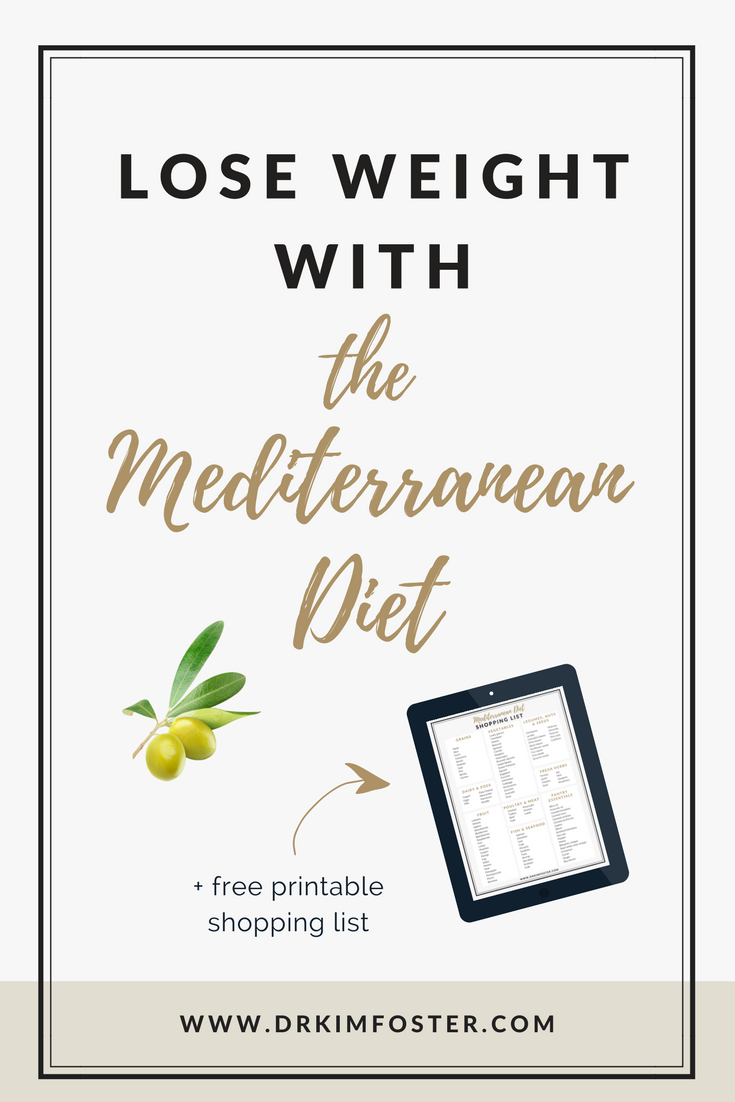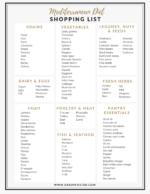Maybe you’ve heard of the Mediterranean Diet. Maybe you’ve thought…that sounds nice. Wine, olive oil, pasta…sound delicious. But I’m interested in losing WEIGHT. I need something more hard core. I need something that will work.
And if that’s you, if that’s your thinking about the Mediterranean Diet…then I’m here to tell you that you have got it all wrong.
One of the topics I write and talk about a lot, as a family doctor and a coach, is weight loss in general, and the Mediterranean Diet in particular. And this week’s YouTube video is all about the Mediterranean Diet.
If you’re tired of overly restrictive and unpleasant fad diets that aren’t sustainable, then the Mediterranean Diet may be for you. In the video I break down exactly how this no-diet way of eating works to help you lose weight–in a pleasurable, delicious way.
I am a huge fan of the Mediterranean diet because of several reasons. For one thing, it is an ancient, traditional diet that has been used in actual populations for a long time, with clear benefit to those populations…but it has also held up to a lot of modern scientific scrutiny.
Plus–and this is probably my favorite thing about the Mediterranean Diet–it is a pleasurable way to eat. And that means that it’s SUSTAINABLE. It’s the opposite of a fad diet. It’s tried and true, and you could adopt it for the rest of your life–and be healthy and happy and enjoy your food because of it.
There’s research to back all of this up. I won’t go into the details–and trust me, there’s a huge body of research on this diet–but overall, research has shown that the Mediterranean diet is associated with a reduced obesity risk, lower BMI, and lower central fat distribution. Not to mention that there’s a lot of strong research to show that the Mediterranean diet reduces the risks of heart disease and diabetes, improving longevity.
Okay, so that’s why I love the Mediterranean Diet in general, but let’s get specific, and talk about how the Mediterranean Diet can help you lose weight.
Factor #1: LOTS OF VEGETABLES
In the Mediterranean Diet there’s a very high vegetable intake, and that’s something that has an extremely favorable effect on weight. There is research to show that Mediterranean-style diets have a beneficial effect on weight loss, and many researchers believe that this effect is due to the focus on plant-based foods that provide a lot of fiber and a lower glycemic load. And, in case you don’t know what I mean by that, I’m going to talk about glycemic load, and glycemic index in a minute, so stay with me.
Anyway, vegetables are great because they average around 90 percent water. All that water increases the volume of food without adding calories, which helps you feel fuller.
Beans and legumes feature prominently in a Mediterranean Diet, and this is something else that likely helps with weight loss. You need both soluble and insoluble fiber to lose weight, and no food has more of these than beans. In your stomach, soluble fiber dissolves in liquid, forming a sort of gel. In your gut, this gel expands and makes you feel fuller. Insoluble fiber, on the other hand, adds bulk to your digestive system and also works together with soluble fiber to make you feel more full.
Factor #2: WHOLE GRAINS
The Mediterranean Diet includes grains. And you might be thinking: I can’t lose weight if I’m eating grains. If I’m eating bread and pasta and carbs.
But the Mediterranean Diet is all about carb QUALITY. The grains you consume in a Mediterranean Diet are WHOLE grains, for the most part, and those are the grains that have a nice low glycemic index.
Glycemic Index, or GI, is a subject worthy of its own video, but in a nutshell, the higher the GI of a given food, the quicker your blood sugar spikes after consuming that food. Which is something you don’t want.
So for weight loss, you want low GI foods–foods that take a long time to break down and digest, and give a nice steady blood sugar release. So the whole grains that are a part of the Mediterranean diet–ancient grains like farro, and bulgur, and oats…these are low GI, and help with weight loss.
Even pasta, which has a place in the Mediterranean diet of course, is traditionally cooked al dente, which carries a lower GI than overcooked mushy pasta that’s no good for anyone…and also tastes terrible.
Factor #3: HEALTHY FATS
The Mediterranean Diet contains fat. Quite a lot of fat, actually. But these are healthy fats. Mostly in the form of olive oil, nuts, seeds, fish, and seafood. AND, there’s a corresponding low consumption of processed foods. So when you get a lot of protein and healthy fats in your diet–that’s a very good thing for satiety, or in other words, keeping you feeling full longer.
Olive oil, in particular, plays a significant role in weight loss on the Mediterranean Diet. Olive oil contains much more healthy monounsaturated fat than other common oils or foods, and studies have shown that consuming olive oil instead of foods high in saturated fat increases your resting metabolism, so you actually burn more calories even you’re sleeping or sitting around.
And that all fish and shellfish that feature so heavily in the Mediterranean Diet, full of protein and heart healthy omega 3s–that also seems to raise your metabolism. One study demonstrated that eating fish at least twice a week could increase your metabolism by as much as 400 calories a day, and prevent expansion of fat cells, especially belly fat. Sounds good, right?
Let’s Recap!
So to recap, the Mediterranean Diet helps you lose weight because of its:
- high vegetable intake, and high amounts of fiber, especially through beans and legumes
- whole grains and high quality carbs that carry a low Glycemic Index
- lots of healthy fats in the form of olive oil, nuts, and seafood
So if you’re feeling convinced, and you’re ready to get started, you’re probably wondering: HOW do I get started on a Mediterranean Diet? Well, fear not, because I am going to be talking about this again in future videos and tutorials, but to get you started, I’ve put together a Mediterranean Diet shopping list that you can download, print off, and take with you to the grocery store. To grab that shopping list, click the thumbnail below.







